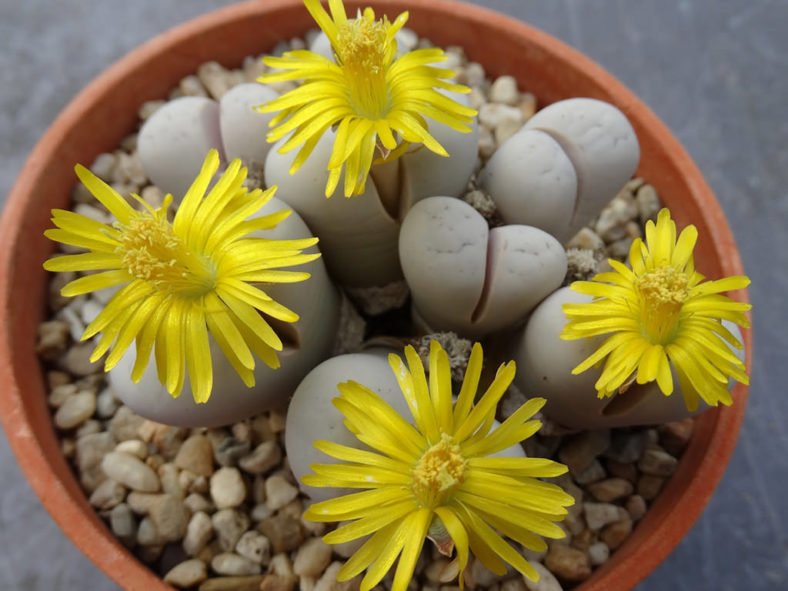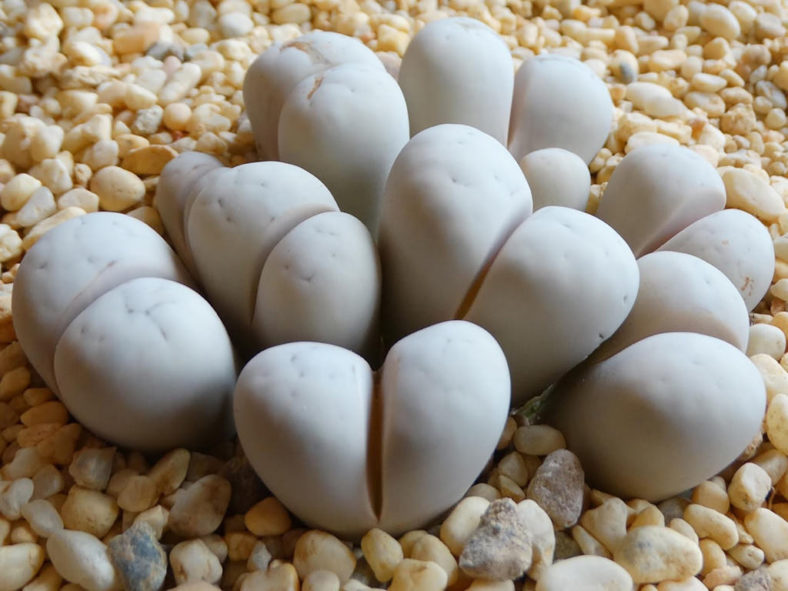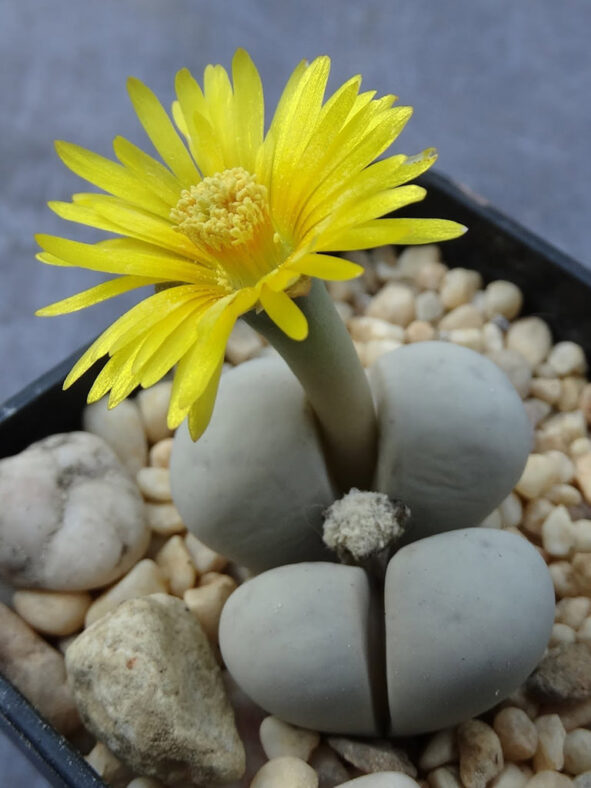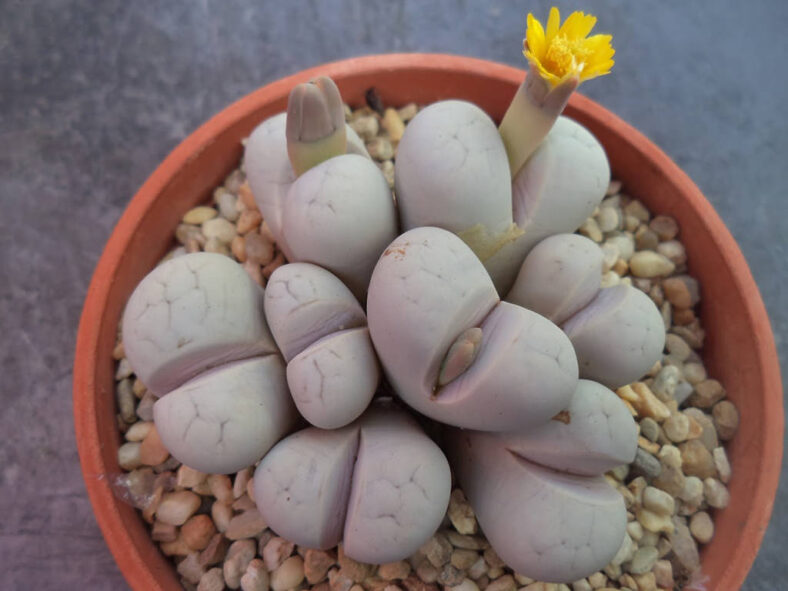Lithops ruschiorum was first described by Nicholas Edward Brown in 1926. This species varies significantly in size, color, and the presence or absence of markings on the upper surface of its body.
Scientific Name
Lithops ruschiorum (Dinter & Schwant.) N.E. Br.
Common Name(s)
Bushman's Buttocks, Hottentot's Buttocks, Rusch's Living Stone
Synonym(s)
Lithops ruschiana, Mesembryanthemum ruschii, Mesembryanthemum ruschiorum
Scientific Classification
Family: Aizoaceae
Subfamily: Ruschioideae
Tribe: Ruschieae
Genus: Lithops
Etymology
The specific epithet "ruschiorum" (pronounced "roos-kee-OR-um") honors Ernst J. Rusch (1867-1957), a German farmer and businessman in Namibia who first collected the species in 1923 in the neighbourhood of Khan Mine.
Origin
Lithops ruschiorum is endemic to Namibia. It grows in rocky areas and cold deserts from Kaokoveld to Swakopmund.
Description
Lithops ruschiorum is a dwarf succulent that typically grows in clusters of 5 to 6 two-lobed bodies, although it can occasionally form larger clumps of up to 30 bodies. Each body consists of a pair of plump, fused leaves that are opposite each other and have a deep central fissure. The leaves are generally bluish-grey, but can also appear yellowish or brownish, with new growths distinctly brown. The bodies can grow up to 1.6 inches (4 cm) tall and 0.8 inches (2 cm) wide at the fissure. The lobes are convex on top and usually have a few faint red lines and spots, although these markings may sometimes be absent. Additionally, some bodies may have faint bluish spots.
In the fall, Lithops ruschiorum produces solitary, yellow flowers that emerge from the fissure between the leaves and can reach a diameter of 1.2 inches (3 cm). The fruits are 5-locular capsules that contain tiny, brown seeds.
Forms (not accepted varieties) of Lithops ruschiorum
- Lithops ruschiorum var. lineata: This form has more clearly visible markings on its bodies, and it occurs from Rocky Point to the Angolan border.
- Lithops ruschiorum var. nelii: This form has smoother and paler bodies, sometimes with few obscure or usually completely absent spots and lines. It occurs in a few locations near Cape Cross.
- Lithops ruschiorum var. ruschiorum

How to Grow and Care for Lithops ruschiorum
Light: A sunny windowsill where the plant receives 4 to 5 hours of direct sunlight during the early part of the day and partial shade during the afternoon is the perfect spot. You may place the plant on the balcony or in the garden from spring to fall.
Soil: Lithops ruschiorum thrives best in soil that will drain quickly. Use a commercial potting mix for succulents, or make your own.
Temperature: High temperatures are not a problem for this plant as long as there is plenty of fresh air, but it is not a cold-hardy succulent. It is hardy in USDA Plant Hardiness Zones 10a-11b, which have average annual extreme minimum winter temperatures ranging from 30°F to 50°F (-1.1°C to 10°C).
Watering: Since this plant has a specific yearly growth cycle, it is essential to water only during certain stages, but it is also important to keep the soil dry at other stages of its growth. How often you need to water Lithops ruschiorum depends on how quickly the soil dries out. Stop watering during the winter to allow the old leaf pair to dry out and the new pair to develop.
Fertilizing: As long as you repot this plant every two years, it does not require any fertilizer.
Repotting: Although this plant can thrive in the same pot for decades, it is beneficial to repot it occasionally to provide more space. The repotting can be done at any time during the growing season, but the best time for repotting is at the beginning of that season.
Propagation: Lithops ruschiorum is primarily propagated from seeds sown in summer. However, if you have a multi-headed plant, it can also be easily propagated by division.
Learn more at How to Grow and Care for Lithops.
Toxicity of Lithops ruschiorum
Lithops ruschiorum is non-toxic and safe to have around children and pets.
Links
- Back to genus Lithops
- Succupedia: Browse succulents by Scientific Name, Common Name, Genus, Family, USDA Hardiness Zone, Origin, or cacti by Genus
Photo Gallery
Click on a photo to see a larger version.


